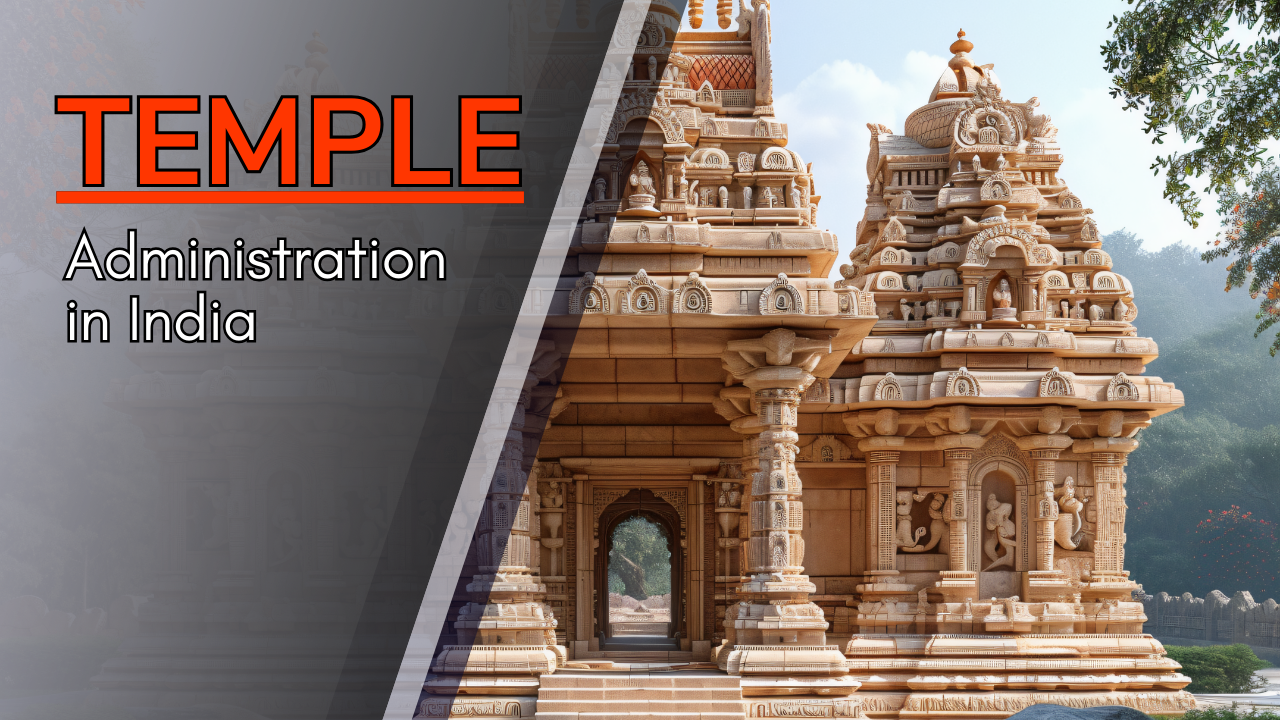Font size:
Print
Temple Administration in India
Context : Temple Administration
As the Supreme Court considers petitions requesting a court-monitored investigation into allegations of ghee adulteration in the laddu prasadam at Lord Venkateswara’s temple, Hindu organisations have renewed their demand for temples to be freed from government control.
More on News:
- The Vishwa Hindu Parishad (VHP) has launched a nationwide campaign, and Andhra Pradesh Deputy Chief Minister Pawan Kalyan has called for the creation of a “Sanatana Dharma Rakshana Board” to address temple-related concerns.
Temple Administration in India:
- Muslims and Christians: They manage their places of worship and religious institutions through community-run boards or trusts.
- Hindu and Others: Many Hindu, Sikh, Jain, and Buddhist places of worship are under significant government control.
- Hindu temples make up the majority of the approximately 30 lakh places of worship in India, according to the 2011 census.
- Tamil Nadu and Andhra Pradesh: In Tamil Nadu, temples are managed by the state’s Hindu Religious and Charitable Endowments (HR&CE) department, while the Andhra Pradesh government controls the Tirumala Tirupati Devasthanams (TTD), appointing its head to oversee the Tirupati Temple.
- States often use a portion of the income from large temple donations and offerings to manage both large and smaller temples, as well as to fund welfare activities like running hospitals, orphanages, or schools that offer secular education.
- Other States: Several states, including Tamil Nadu, Karnataka, Andhra Pradesh, Telangana, Kerala, Maharashtra, Odisha, Himachal Pradesh, Bihar, Madhya Pradesh, and Rajasthan, have passed laws granting the government the authority to manage temples, their finances, and expenditures.
- In the former state of Jammu and Kashmir, the Jammu and Kashmir Shri Mata Vaishno Devi Shrine Act, 1988, was enacted to specifically manage the Vaishno Devi Mata Shrine in Katra.
- Source of Authority: The states derive their power to enact such legislation from Article 25(2) of the Constitution, which allows the government to regulate or restrict secular activities associated with religious practices and to promote social welfare and reform, including opening Hindu religious institutions to all classes of Hindus.
- Religious endowments and institutions fall under List III (Concurrent List) of the Seventh Schedule, allowing both the Centre and states to legislate on the matter.
How did Hindu temples come under Government Control?
- Earliest Evidence: The earliest evidence of monumental temple construction in India dates back to the Mauryan period (321-185 BCE).
- Throughout history, kings and nobles have donated land and wealth to temples, which became important centres of culture and economy.
- Larger temples played a key role in promoting agriculture, irrigation, and driving economic activity.
- Mediaeval Period: In the mediaeval period, India’s wealthy temples were frequently attacked and looted by invaders.
- Colonial Rule: During colonial rule, the British sought to control temples, and between 1810 and 1817, the East India Company passed several laws in the presidencies of Bengal, Madras, and Bombay, granting itself the authority to interfere in temple administration, ostensibly to prevent mismanagement of temple income and endowments.
- In 1863, the British enacted the Religious Endowments Act, transferring temple control to committees established under the Act.
- However, the government maintained significant influence through judicial oversight, the extension of the Civil Procedure Code and Official Trustees Act to temples, and the Charitable and Religious Trusts Act of 1920.
- In 1925, the Madras Hindu Religious Endowments Act empowered provincial governments to legislate on endowments. This law granted extensive oversight powers to a board of commissioners, which could even take over temple management.
- After Independence: After Independence, the 1925 Act served as a model for states to create their own temple administration laws.
- The first such law was the Madras Hindu Religious and Charitable Endowments Act of 1951, which introduced the supervision of temples by the HR&CE department and the appointment of an Executive Officer.
- Although the Madras law was struck down by the courts, it was re-enacted in 1959 with some amendments.
- A similar law was passed in Bihar around the same time.
- Present: Today, most South Indian states follow similar legal frameworks for temple control.
- Government intervention has been argued to be necessary to ensure equal access for all castes to Hindu places of worship.
Demand for freeing Temples from Government Control?
- The RSS first passed a resolution in 1959, calling for the return of the Kashi Vishwanath temple to Hindus and criticising government control over various spheres of life. In 1988, the RSS urged state governments to hand over temples to Hindu devotees, arguing that government control was “unfair” and motivated by temple funds.
- The VHP has been advocating for freeing temples from government control since the 1970s, passing a resolution in 2021 for a central law on the matter.
- Former MP Satyapal Singh introduced private member’s bills in 2017 and 2019 to free temples from government control.
- In 2019, the Uttarakhand government enacted the Char Dham Devasthanam Management Act, which was later repealed in 2021 after protests.
- In 2023, the Madhya Pradesh government reduced state control over temples, while similar steps in Karnataka by Basavaraj Bommai’s government were not implemented before he left office.
Legal Position:
- There have been arguments in favour of freeing temples from government control, but courts have largely been hesitant to intervene.
- In the 1954 Shirur Mutt case, the Supreme Court ruled that any law transferring the right of administration of a religious denomination to another authority would violate Article 26(d), which guarantees the right to manage property according to the law.
- However, the Court also held that the state has the general right to regulate the administration of religious or charitable institutions and endowments.
- In the 1954 case of Ratilal Panachand Gandhi vs The State of Bombay, the Supreme Court affirmed that the right to manage religious affairs is a fundamental right that cannot be taken away by law, although the state can regulate the administration of trust properties through valid legislation.
- In the 1996 case of Pannalal Bansilal Pitti vs. State of Andhra Pradesh, the Supreme Court upheld a law abolishing the hereditary right to chairmanship of trusts managing Hindu religious institutions or endowments.
- The Court also rejected the argument that such laws must apply uniformly across all religions.
- In 2022, lawyer Ashwini Upadhyay filed a writ petition in the Supreme Court to free temples from government control. However, the Court observed that temples under government oversight have served broader societal needs beyond religious purposes. It cautioned that reversing the current system would “turn the clock back” to a time when temples were centres of wealth. Following this, Upadhyay withdrew his petition.
Subscribe to our Youtube Channel for more Valuable Content – TheStudyias
Download the App to Subscribe to our Courses – Thestudyias
The Source’s Authority and Ownership of the Article is Claimed By THE STUDY IAS BY MANIKANT SINGH





